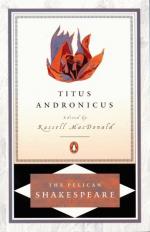|
This section contains 5,938 words (approx. 20 pages at 300 words per page) |

|
SOURCE: "Cultural Disintegration in Titus Andronicus: Mutilating Titus, Vergil, and Rome," in Themes in Drama, Vol. 13, 1991, pp. 123-40.
(In the following excerpt, James suggests that Shakespeare employs Vergilian and Ovidian models in Titus Andronicus to perform a critique of Roman traditions and values.
I
The impulse to dismember and devour pervades this revenge drama: it motivates not only the revenge plots of Titus and Tamora, but also Shakespeare's curious handling of literary authorities, particularly Vergil and Ovid. In treating the classical texts of imperial Rome, Shakespeare replicates the tragedy's patterns of competition, mutilation, and digestion—the latter a term for imitations which absorb and transform their sources. His purpose, in part, is to 'overgo' Vergil and Ovid, as well as the classicizing and violent dramas of Kyd and Marlowe. But Shakespeare's aemulatio and digestio go further to perform a critique of imperial Rome on the eve of its...
|
This section contains 5,938 words (approx. 20 pages at 300 words per page) |

|


